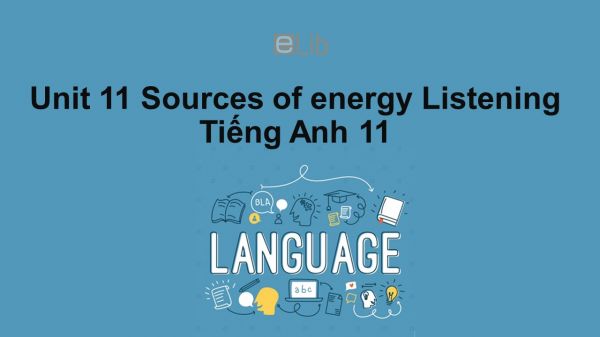Unit 11 lớp 11: Sources of energy-Listening
Bài học Unit 11 lớp 11 "Sources of energy" phần Listening hướng dẫn các em kỹ năng nghe hiểu về chủ đề năng lượng để hoàn thành bài tập dạng trắc nghiệm và điền từ để hoàn chỉnh thông tin.
Mục lục nội dung

Unit 11 lớp 11: Sources of energy-Listening
1. Before You Listen Unit 11 lớp 11
Work in pairs. List some of the things you use energy for in your house (Làm việc theo cặp. Liệt kê một số trong những thứ sử dụng năng lượng trong nhà của bạn)
They are rice cooker, air-conditioner, fridge, lights, television, ...
(Chúng là nồi cơm điện, điều hòa, tủ lạnh, đèn, tivi, ...)
Listen and repeat (Lắng nghe và nhắc lại)
ecologist resources renewable
fossil fuels unlimited fertilized
2. While You Listen Unit 11 lớp 11
2.1. Task 1 Unit 11 lớp 11
Listen and complete the sentences by circling the letter A, B, C or D (Nghe và hoàn thành câu bằng cách khoanh tròn chữ cái A, B, C hoặc D)
1. Ecology is the study of…………
A. human beings and animals
B. the environment and solar energy
C. natural and alternative resources
D. human beings and their environment
2. The natural environment consists of……………
A. the oceans and the land
B. the sun and the air
C. all natural resources
D. the air and the oceans
3. If the resource can be…………, it is called renewable.
A. burnt quickly
B. used easily
C. divided properly
D. replaced quickly
4. Grass for animals is a………… resource.
A. renewable
B. nonrenewable
C. limited
D. clean
5. According to the passage, coal is nonrenewable because it takes ………to make it.
A. billions of years
B. millions of years
C. three million years
D. three billion years
Guide to answer
1. D 2. C 3. D 4. A 5. B
1. Ecology is the study of human beings and their environment.
(Sinh thái học là ngành nghiên cứu về con người và môi trường.)
2. The natural environment consists of all natural resources.
(Môi trường tự nhiên bao gồm tất cả các nguồn tài nguyên thiên nhiên.)
3. If the resource can be replaced quickly, it is called renewable.
(Nếu nguồn tài nguyên được thay thế nhanh chóng, chúng được gọi là có thể tái tạo lại.)
4. Grass for animals is a renewable resource.
(Cỏ cho động vật là một nguồn tài nguyên có thể tái tạo lại.)
5. According to the passage, coal is nonrenewable because it takes millions of years to make it.
(Theo đoạn văn, than không khổng phục hồi lại vì mất hàng triệu năm để tạo ra nó.)
2.2. Task 2 Unit 11 lớp 11
Listen again to the last part of the talk and write in the missing words (Nghe lại đến phần cuối của bài nói và viết các từ còn thiếu)
Guide to answer
Solar enerey, air, and water are renewable resources because there is an (1) unlimited supply. However, this definition may change if people are not careful with these resources. The amount of solar energy that reaches the earth depends on the (2) atmosphere. If the atmosphere is polluted, the solar energy that reaches the earth (3) may be dangerous. If life is going to continue, the air must contain the correct amount of nitrogen (N), oxygen (O), carbon dioxide (CO), and other (4) gases. If humans continue to pollute the air, it will not contain the correct (5) amount of these gases.
Tạm dịch
Năng lượng mặt trời, không khí và nước là các nguồn tài nguyên có thể tái tạo vì có một nguồn cung cấp vô tận. Tuy nhiên, định nghĩa này có thể thay đổi nếu con người không cẩn thận với những nguồn tài nguyên này. Lượng năng lượng mặt trời đến Trái Đất phụ thuộc vào tầng khí quyển. Nếu khí quyển bị ô nhiễm, năng lượng mặt trời đến Trái Đất có thể rất nguy hiểm. Nếu muốn sự sống tiếp tục, không khí phải có chính xác lượng khí ni-tơ, ô-xi, cacbonic và các khí ga khác. Nếu loài người tiếp tục làm ô nhiễm không khí, nó sẽ không có chính xác những lượng khí ga đó nữa.
Tapescript
The natural environment includes all natural resources that are necessary for life: the air. the oceans, the sun and the land. Because they are vital for life these resources must be protected from pollution and conserved. Ecologists study their importance and how to use them caretully.
According to ecologists, resources are divided into 2 groups: renewable and non-renewable. When a resource can be replaced quickly, it is called renewable. If it cannot be replaced quickly and easily, it is non renewable. For example grass for animals is a renewable resource. When cows eat the grass, the resource is used. If the soil is fertilized and protected, more grass will grow. Coal, however, is nonrenewable because it takes millions of years to make coal. All fossil fuels are nonrenevvable resources.
Solar energy, air, and water are renewable resources because there is an unlimited supply. However, this definition may be changed if people are not careful with these resources. The amount of solar energy that reaches the earth depends on the atmosphere. If the atmosphere is polluted, the solar energy that reaches the earth may be dangerous. If life is going to continue, the air must contain the correct amount of nitrogen (N), oxygen (O), carbon dioxide (CO:), and other gases. If humans continue to pollute the air, it will not contain the correct amount of these aases.
Tạm dịch
Môi trường tự nhiên bao gồm tất cả các nguồn tài nguyên thiên nhiên cần thiết cho sự sống: không khí, các đại dương, mặt trời và đất. Vì chúng là thiết yếu cho sự sống, các nguồn này phải được bảo vệ khỏi ô nhiễm và được bảo tồn. Các nhà sinh thái học nghiên cứu tầm quan trọng của chúng và cách sử dụng chúng một cách cẩn thận.
Theo các nhà sinh thái học, các nguồn năng lượng được chia thành 2 nhóm: có thể tái tạo và không thể tái tạo. Khi một nguồn có thể được thay thế một cách nhanh chóng, nó được gọi là tái tạo. Nếu nó không thể được thay thế một cách nhanh chóng và dễ dàng, nó không thể tái tạo. Ví dụ cỏ cho động vật là nguồn tái tạo. Khi bò ăn cỏ, tài nguyên được sử dụng. Nếu đất được bón phân và bảo vệ, sẽ có nhiều cỏ hơn. Than tuy nhiên không thể tái tạo được vì phải mất hàng triệu năm để tạo ra than. Tất cả các nhiên liệu hóa thạch là nguồn tài nguyên không thể tái tạo được.
Năng lượng mặt trời, không khí, và nước là nguồn năng lượng có thể tái tạo vì nó là nguồn cung cấp không giới hạn. Tuy nhiên, định nghĩa này có thể được thay đổi nếu người ta không cẩn thận với các tài nguyên này. Lượng năng lượng mặt trời đến Trái Đất phụ thuộc vào khí quyển. Nếu bầu khí quyển bị ô nhiễm, năng lượng mặt trời đến trái đất có thể nguy hiểm. Nếu cuộc sống vẫn tiếp tục, không khí phải chứa lượng thích hợp nitơ (N), oxy (O), CO2 (carbon dioxide), và các loại khí khác. Nếu con người tiếp tục gây ô nhiễm không khí, nó sẽ không chứa số lượng của các khí này một cách phù hợp.
3. After You Listen Unit 11 lớp 11
Which group do these sources of energy belons to? Put a tick (✓) in the right column. (Các nguồn năng lượng này thuộc vào nhóm nào? Đặt dấu (✓) vào cột đúng)
Guide to answer
4. Practice
4.1. Complete the sentences
Complete the sentence with the correct form of the given verb (Hoàn thành câu với dạng đúng của những từ đã cho)
exhaust release alternate research relate
supply renew pollute harm finite
1. Coal, gas and oil are ______ forms of energy that can not be replaced after used.
2. The nuclear plant provides a fifth of the nation's energy ______.
3. Solar energy is not only plentiful and ______ but also clean and safe.
4. Increased consumption will lead to faster ______ of our natural resources.
5. Electricity companies were criticized for failing to develop ______ energy sources.
6. Oxygen from the water is ______ into the atmosphere.
7. Fossil fuels will be exhausted within a ______ short time.
8. How to make full use of these sources of energy is a question for ______ all over the world.
9. These pesticides are environmentally ______.
10. Water power provides energy without ______.
4.2. Multiple-choice
Để bổ sung từ vựng cho phần nghe, mời các em đến với đề kiểm tra trắc nghiệm Unit 11 Listening Tiếng Anh 11 sau đây và cùng luyện tập.
5. Conclusion
Qua bài học này các em cần lưu ý các từ vựng sau đây
- ecologist [i'kɔlədʒist] (n): nhà sinh thái học
- ecology [i'kɔlədʒi] (n): sinh thái học
- fertilize ['fə:tilaiz] (v): bón phân
- grass [grɑ:s] (n): cỏ
- land [lænd] (n): đất
- ocean ['əʊ∫n] (n): đại dương
- petroleum [pə'trouliəm] (n): dầu hỏa, dầu mỏ
- replace [ri'pleis] (v): thay thế
Tham khảo thêm
- doc Unit 11 lớp 11: Sources of energy-Reading
- doc Unit 11 lớp 11: Sources of energy-Speaking
- doc Unit 11 lớp 11: Sources of energy-Writing
- doc Unit 11 lớp 11: Sources of energy-Language Focus





